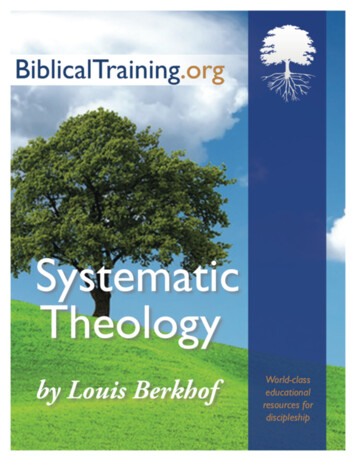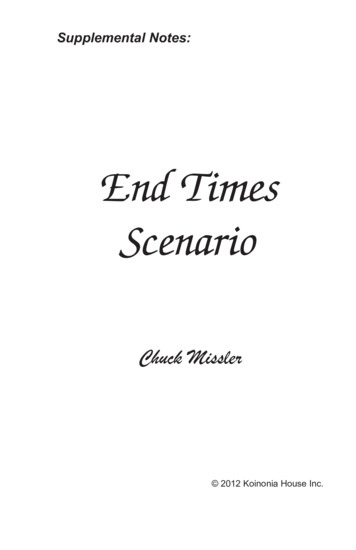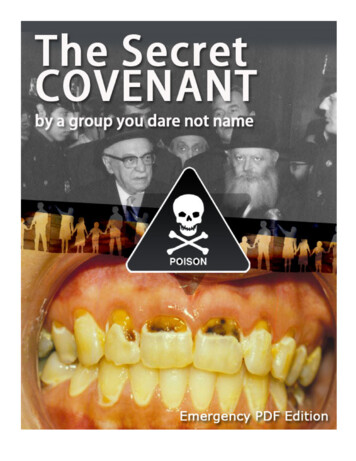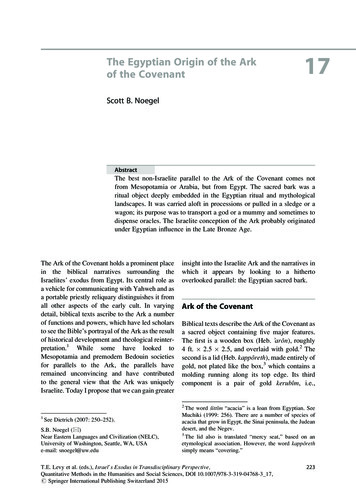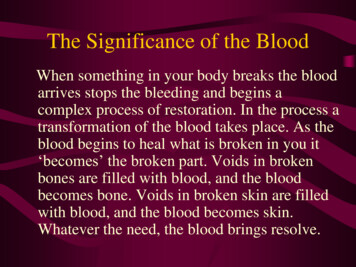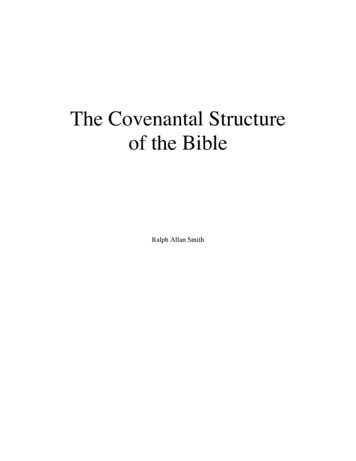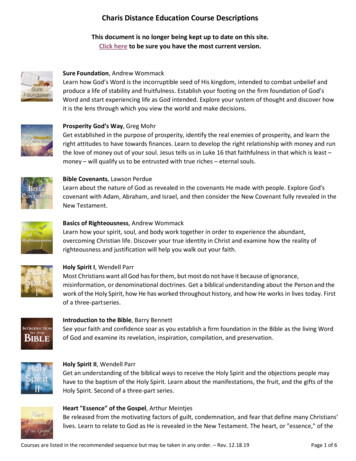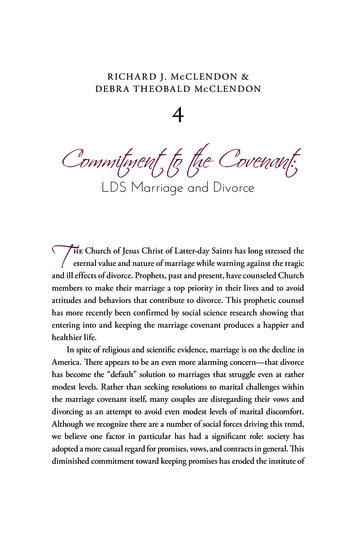
Transcription
R IC H A R D J. M c C L E N D ON &DE BR A T H E OB A L D M c C L E N D ON4Commitment to the Covenant:LDS Marriage and DivorceThe Church of Jesus Christ of Latter-day Saints has long stressed theeternal value and nature of marriage while warning against the tragicand ill effects of divorce. Prophets, past and present, have counseled Churchmembers to make their marriage a top priority in their lives and to avoidattitudes and behaviors that contribute to divorce. This prophetic counselhas more recently been confirmed by social science research showing thatentering into and keeping the marriage covenant produces a happier andhealthier life.In spite of religious and scientific evidence, marriage is on the decline inAmerica. There appears to be an even more alarming concern—that divorcehas become the “default” solution to marriages that struggle even at rathermodest levels. Rather than seeking resolutions to marital challenges withinthe marriage covenant itself, many couples are disregarding their vows anddivorcing as an attempt to avoid even modest levels of marital discomfort.Although we recognize there are a number of social forces driving this trend,we believe one factor in particular has had a significant role: society hasadopted a more casual regard for promises, vows, and contracts in general. Thisdiminished commitment toward keeping promises has eroded the institute of
By Divine Designmarriage; driving significant numbers to postpone marriage, enticing many toabandon marriage for cohabitation, and for those who are married, weakeningtheir will to endure modest challenges and tempting them to see their marriage as a temporary obligation rather than a long-term one.Unfortunately, members of The Church of Jesus of Christ of Latter-daySaints have also been influenced by this cultural trend. We will furtherexplore this issue and discuss ways that Latter-day Saints can inoculatethemselves against adopting such attitudes toward their marital vows andrealign themselves with the words of the prophets, scripture, and soundscientific research.The Problem: The Loss of Commitmentand the Divorce CultureSocial change commonly occurs in slow and steady doses. Trends that producenew ideas and beliefs eventually establish new values and norms. Because ittakes time, shifts in values usually come in subtle transitions of which societymay be largely unaware. Although some of these values may be good forsociety, many are harmful. In these cases, unless a person becomes conscientious of and alerted to their dangers, he or she can easily slip into believingthat such values and behaviors are acceptable in God’s eyes. As a protectionagainst this, the Lord has warned Latter-day Saints to “beware concerning[them]selves” (D&C 84:43). He has also cautioned that even the “humblefollowers of Christ” in the latter days will be “led, that in many instances theydo err because they are taught by the precepts of men” (2 Nephi 28:14). Thiscounsel provides a striking reminder that we must be vigilant when encountering social change.One of the subtle, yet harmful, value shifts that has occurred over thatpast several decades has been a drift toward casualness in our commitments,agreements, and promises. Such a trend can be found in business, law, andpolitics, where making promises and contracts is a natural aspect of theoperation of business. Unfortunately, today parties to agreements no longer94
Commitment to the Covenant have high expectations that their contracts will be honored. Perhaps, however, no other aspect of society has been affected as significantly by thistrend than has the institution of marriage. What was once a promise “untildeath do you part” has now shifted to “until debt do you part.” The holybinding of husband and wife is no longer seen as a firm promise “throughsickness and in health” but has largely been reduced to the level of a flimsyhigh school promise of “going steady,” where the relationship is easily dissolved for any number of insignificant reasons.Historically, marriage was largely viewed by both individuals and societyat large with a deep level of commitment and satisfaction. From a social science perspective, this level of commitment is not misplaced. In their widelyacclaimed book The Case for Marriage, Waite and Gallagher (2000) reportedthat married individuals have, on average, significantly higher levels of happiness, physical and emotional health, and financial well-being when compared to singles, cohabiters, or divorcees. In addition they found that the largemajority (86%) of unhappily married people who stayed married had happiermarriages five years later. In other words, “permanent marital unhappiness issurprisingly rare among the couples who stick it out” (pp. 148–149). Furtheranalysis by Waite and colleagues (2002) found that unhappily married adultswho divorced or separated were no happier, on average, than unhappily married adults who stayed married. They also reported that even unhappy spouseswho had divorced and remarried were no happier, on average, than unhappyspouses who stayed married. Thus, if people choose divorce because theythink it will bring them a sense of greater happiness that has eluded themwithin the marriage, existing research shows little if any evidence that theirassumption is true (p. 4).In spite of these compelling findings, the past several decades ofAmerican culture have weakened public support for the marriage vow.Marriage rates are down, and divorce is now often advocated as a solution to marital difficulties culturally, politically, and legally. According toWaite and Gallagher (2000), much of this shift in attitude can be attributed to the “privatization of marriage” in which marriage is regarded as95
By Divine Designa private and individual decision (p. 176). When struggling with maritaldifficulty and considering whether to divorce, the central question oftenasked by individuals today is, “What would make me happy?” This question is often promoted by lawyers, educators, counselors, and even clergy,reinforcing “the idea that emotional gratification is the main purpose andbenefit of marriage” (p. 176). Elder Dallin H. Oaks (2012) recently quoteda Harvard law professor in his description of the current law and attitudetoward marriage and divorce: “The [current] American story about marriage, as told in the law and in much popular literature, goes somethinglike this: marriage is a relationship that exists primarily for the fulfillmentof the individual spouses. If it ceases to perform this function, no one isto blame and either spouse may terminate it at will” (p. 44). This selffocused perspective is contributing to our culture’s anti-commitment attitudes. It underlies what is driving an unprecedented increase in maritalpostponement and cohabitation in the United States, and is eroding thebarrier that once protected society against a casual acceptance of divorce.In the late 1960s through the lobbying efforts of lawyers, no-faultdivorce came on the American scene to make divorce a faster and lessjudgmental legal process. It has created a legal culture regarding marriageand divorce that has spilled over into societal attitudes toward marriagein general. Being married has little distinction from that of cohabitation.“Thanks to no-fault, the marriage contract is no longer enforceable. It takestwo to marry but only one to divorce at any time, for any reason, as fast asthe courts can sort out property and custody issues” (Waite & Gallagher,2000, p. 178).How have these social and legal trends affected marriage and divorceamong Latter-day Saints? McClendon and Chadwick (2005) found thatmost marriages in the Church continue to be strong and vibrant. When compared to the national percentages, Latter-day Saints are significantly differentthan their national peers showing lower age at first marriage, lower numbersof single-parent families, and larger family size. Like the national average,Latter-day Saints also rank extremely high in marital happiness. Many96
Commitment to the Covenant scholars believe that the current lifetime divorce rate in the United Statesis between 40% and 50%. In their examination of the divorce rate withinThe Church of Jesus Christ of Latter-day Saints, using both civil and templemarriages combined, McClendon and Chadwick (2005) estimated that thecurrent lifetime divorce rate for returned-missionary men to be approximately12% and for returned-missionary women around 16%. They estimated thatthe lifetime rate for non-returned missionary men to be approximately 38%and about 22% for non-returned-missionary women (p. 39). These data showthat although divorce rates among Latter-day Saints are lower than they are inthe general American public, divorce has definitively found its way into mainstream Latter-day Saint culture. Church leaders are mindful of this trend andof the ever-present attacks that Satan places on the family in general. ElderL. Tom Perry (2012) recently warned, “As we know, [Satan] is attempting toerode and destroy the very foundation of our society—the family. In cleverand carefully camouflaged ways, he is attacking commitment to family lifethroughout the world and undermining the culture and covenants of faithfulLatter-day Saints” (p. 27).In a bold statement to members of the Church about marriage anddivorce, President Gordon B. Hinckley (1991) declared:Of course, all in marriage is not bliss. . . . The remedy for mostmarriage stress is not in divorce. It is in repentance. It is not inseparation. It is in simple integrity that leads a man to square uphis shoulders and meet his obligations. It is found in the GoldenRule. . . .There must be a willingness to overlook small faults, to forgive,and then to forget.There must be a holding of one’s tongue. Temper is a viciousand corrosive thing that destroys affection and casts out love. . . .There may be now and again a legitimate cause for divorce. I amnot one to say that it is never justified. But I say without hesitationthat this plague among us, which seems to be growing everywhere,97
By Divine DesignPresdient Hinckley taught: "The remedy for most marriage stress is not in divorce. It isin repentance. It is not in separation. It is in simple integrity that leads a man to squareup his shoulders and meet his obligations. It is found in the Golden Rule." Auremar.is not of God, but rather is the work of the adversary of righteousness and peace and truth. (pp. 72–74)This prophetic warning voice helps us as Latter-day Saints to recognizethat a thorough and complete commitment to the marriage vow and to Godis at the center of a successful marriage. Our purpose now is to discuss morespecifically this counsel and to find ways to apply it. Before we do so however,we want to note that we are discussing ideas and solutions that can aid us inattaining the ideal. We are well aware that in mortality attaining the ideal isnot always possible, but seeking after it is. As the authors, we ourselves wouldbe defined by the current societal standard as a “blended family.” We have personal understanding of the heartache of divorce, the trauma of chronic problems that seem to have no solution no matter how hard one tries to have faithand behave well, and the sensitivity that is required to raise children whoselives are splintered between two households. This personal perspective has98
Commitment to the Covenant supported and even strengthened our religious and scientific convictions aboutcommitment in marriage and has contributed to our strong position about theresponsibility each of us has to hold tenaciously to the ideal. Certainly, themanner in which the ideal is implemented in families will vary based on individual circumstances (see The Family: A Proclamation to the World, 1995),but some core principles can help guide and sustain us as we make decisionsregarding that implementation.The Solution: Fierce Loyalty to theCovenant of Marriage and to GodIn light of the current societal and cultural trends regarding marriage, whatcan be done to stem the tide of casual marital commitments? We discussthree solutions that will revitalize marriage and reenthrone commitment atthe forefront of marriage. The first is to “mean what you say” in regards toentering into and keeping the marital promise. Fierce loyalty to one’s vowwill produce greater trust between spouses which in turn builds greater loyalty and investment in the marriage. Second is to “do” marriage. A maritalcommitment is more than just saying “yes” or “I do” during the marriageceremony. It requires daily actions of love and service to fully honor thepromise. Finally, “look to God” as a partner in the marriage covenant. Hisinfluence will provide assurances and peace for spouses that will give themgreater courage and determination to work together through marital differences and challenges.Mean What You SayFierce loyalty to one’s word is the foundation of trust in all relationships,especially marriage. It has been said thatcommitment is what transforms a promise into a reality. It is thewords that speak boldly of your intentions, and the actions that99
By Divine Designspeak louder than words. It is making time when there is none;coming through time after time after time, year after year afteryear. Commitment is the stuff character is made of—the powerto change the face of things. It is the daily triumph of integrityover skepticism. (Commonly attributed to Abraham Lincoln orShearson Lehman Brothers)When we truly mean what we say and are willing to defend our word atall costs and in all situations, we create a special bond of trust that elevatesthe marital relationship and protects it during tests and challenges. If wetruly love our spouse, we will clearly express to them our deep loyalty toour marital commitment. Elder Jeffrey R. Holland (2012) recently said that“the crowning characteristic of love is always loyalty.”Waite and Gallagher (2000) found an interesting correlation betweenmarital loyalty and marital investment: “The more uncertain people are thatany partnership will last, the more they act as individuals and the less theyact as permanent partners. But the more spouses act as separate individuals,the less they get from the marriage partnership, and the more likely the marriage will fail” (p. 180). Of course, this type of self-fulfilling prophecy alsoworks conversely. When spouses clearly communicate to each other that theyare fully committed to honoring their marital vows and that divorce is not anoption, they will invest in their marriage with greater confidence, which inturn naturally promotes greater loyalty and commitment.The Book of Mormon’s strong emphasis on covenant-making can teachus how to “mean what we say” when it comes to keeping our covenants,especially in marriage. The Nephite/Lamanite culture, like the Hebrew culture, viewed the making of an oath or covenant as a final vow, never to bebroken. When problems arose or were anticipated, they either didn’t enterinto the covenant in the first place or they worked within the covenant toresolve problems. They never considered that they would break the covenant. The story of Nephi and Zoram illustrates this principle. After Zoramdiscovered that Nephi was not Laban, as he had presumed, Nephi made an100
Commitment to the Covenant As spouses act like and treat their partnership as a permanent relationship, they will actmore like permanent partners and less like individuals. David Stoker, IntellectualReserve, Inc.oath wherein he promised Zoram that he would spare his life and make hima free man if he went with him and his brothers into the wilderness. We aretold that “Zoram did take courage” upon hearing Nephi’s oath and reassurances that he need not fear for his life. To this, Zoram then respondedwith his own oath that he would “tarry with [them] from that time forth”(1 Nephi 4:35). Nephi then stated, “When Zoram had made an oath untous, our fears did cease concerning him” (v. 37).Surprisingly, this commitment to keeping one’s promise was also thebelief and practice among the more wicked Nephites and Lamanites. Althoughthey allowed themselves to commit serious sins, they were strongly socializedagainst violating a promise. For example, in Alma 44, Captain Moroni commanded the Lamanite army to make a covenant of peace or they would be101
By Divine Designdestroyed. Zerahemnah, the captain of the Lamanites, rejected the offer bysaying, “We will not suffer ourselves to take an oath unto you, which we knowthat we shall break” (v. 8). Although his private goal was to deceive and murderin order to gain power, because of the cultural norms of the day, Zerahemnahwas not willing to make an oath that he knew he would likely break. Later,when Zerahemnah and his army were at the brink of being destroyed, he didchoose to make an oath of peace and—to the modern-day reader’s surprise—he kept it. There is no record that Zerahemnah himself ever returned.The Book of Mormon also illustrates for us the power that keepingoaths and covenants has in unifying and building trust and loyalty. WhenAmalickiah conspires to be king, Captain Moroni rallies the people to defendtheir lands, liberty, and religion. Moroni does this by establishing a covenantand raising the title of liberty, explaining:Whosoever will maintain this title upon the land, let them comeforth in the strength of the Lord, and enter into a covenant thatthey will maintain their rights, and their religion, that the LordGod may bless them.And it came to pass that when Moroni had proclaimed thesewords, behold, the people came running together with their armorgirded about their loins, rending their garments in token, or as acovenant, that they would not forsake the Lord their God; or, inother words, if they should transgress the commandments of God,or fall into transgression, and be ashamed to take upon them thename of Christ, the Lord should rend them even as they had renttheir garments. (Alma 46:20–21)Those who entered into a covenant of liberty centered their commitment in Christ and were true to the promises they made, even at the perilof their lives. This level of commitment allowed the Nephites to synergizetheir trust in each other and to build the type of loyal community necessaryfor Moroni to lead and eventually win the war against the Lamanites.102
Commitment to the Covenant Another Book of Mormon example that illustrates the unifying,strengthening power of keeping covenants is that of the two thousandstripling warriors. Their special preservation through several battles canbe traced back to the covenant that both they and their parents made withthe Lord. Their parents made an oath with God that they would neveragain take up their swords to battle, but rather, if necessary, give their livesas a token of their commitment. Later, so their parents could continue tohonor their covenant, their sons covenanted to give their lives if necessary for the defense of their freedom, family, and country. Although theyfought and many were injured, their lives were preserved through theirfaith in God and their belief that as they kept their commitment to him,he would deliver them (see Alma 57:26–27).Keeping our commitments, then, is one of the most important valueswe can embrace. A discussion about values is not limited to a religious discussion or a recitation by the young women during our Sunday block ofchurch meetings. Values are at the core of our daily living. We espouse valuesin many realms, such as spiritual/religious, health/fitness, educational/professional, family/child-rearing, civic/political, relationships with others, etc.Psychological models have begun to understand the mental health benefitsof living our lives in a manner consistent with our values. Acceptance andCommitment Therapy (ACT) is a therapy model in which helping clientspursue a life consistent with their values plays a prominent role in the therapeutic process. When values are sacrificed in the service of fears, doubts,frustrations, anxieties, disappointments, and the like, life is put into a stateof paralysis. The belief that one “can only be happy when . . .” becomes aself-fulfilling prophecy as the “when” often doesn’t come in the manner orin the timing that might be preferred. Instead, ACT maintains that peoplecan experience difficulties, even chronic problems, and still move forwardin their lives in pursuit of their deeply held values. “Willingness to experience difficult thoughts, feelings, and experiences is put in the service of ourvalues. This is what makes willingness different from wallowing” (Luoma,Hayes, & Walser, 2007, p. 41). Thus, when values are sustained and pursued,103
By Divine Designmental health and life satisfaction improves, even when external circumstances do not necessarily improve. Lorde (1997) has said: “When I dare tobe powerful, to use my strength in the service of my vision, then it becomesless important whether or not I am unafraid” (p. 13). Thus, if we mean whatwe say when we commit to our marital covenants, we demonstrate to ourspouse, our God, and others in our personal life a deep sense of integrityregarding one of our most important values.“Do” MarriageA second solution to strengthen commitment to the covenant is to “do” marriage in God’s way. We learn in Doctrine and Covenants 19:11 that “eternal” isanother name for God. Within Latter-day Saint circles, the term “eternal marriage” is sometimes used casually, spoken with an apparent assumption thatonce a man and woman are sealed in the temple they have an eternal marriage.However, the phrase “eternal marriage” represents God’s marriage, or in otherwords, the quality of marriage that God enjoys. A temple sealing ceremony isonly the beginning step necessary to achieve this type of marriage. The marriage, as an entity of its own, requires daily work from both partners if it is toattain the same quality as is enjoyed in the heavenly realms.Elder Oaks (2007) has said, “The kind of marriage required for exaltation—eternal in duration and godlike in quality—does not contemplatedivorce” (p. 70). Along this vein, however, some people claim commitmentto the covenant as a reason for staying in a difficult marriage, yet treat theirspouse with disrespect and even contempt, or suffer passively with resignation to an unhappy lot. Allow us to be bold and assert that physically stayingin the marriage is only one of many steps that are required in order to fullyhonor the marital covenant—one must remain emotionally and spirituallypresent and do all that is possible to create the type of relationship worthyof the title “eternal marriage.” Elder Oaks further said: “Under the law ofthe Lord, a marriage, like a human life, is a precious, living thing. If ourbodies are sick, we seek to heal them. We do not give up. While there is any104
Commitment to the Covenant A temple sealing ceremony is only the beginning of an eternal marriage. Marriage requiresdaily work from both partners to attain the quality of God's marriage. Rezolution Films, Intellectual Reserve, Inc.prospect of life, we seek healing again and again. The same should be trueof our marriages, and if we seek Him, the Lord will help us and heal us”(pp. 71–73).We are, therefore, advocating a higher law which encourages prioritizingthe building and strengthening of the marriage relationship until it can growand flourish into one that is God-like in quality. “In the strongest marriages,husband and wife share a deep sense of meaning. They don’t just ‘get along’—they also support each other’s hopes and aspirations and build a sense of purpose into their lives together” (Gottman & Silver, 1999, p. 23). The followingstory, told by Elder Spencer J. Condie (1993) illustrates how a couple canelevate their relationship by working within the covenant:A few years ago my wife, Dorothea, and I were walking across thegrounds of a temple in a foreign land when we met a very radiant,cheerful, silver-haired sister. Her cheerful, Christlike countenance105
By Divine Designseemed to set her apart from those around her, and I felt inclinedto ask her to explain why she looked so happy and content with life.Well, . . . several years ago I was in a hurry to get married, andquite frankly, after a few months I realized I had married the wrongman. . . . He had no interest in the Church as he had initially ledme to believe, and he began to treat me very unkindly for severalyears. One day I reached the point where I felt I could go on nolonger in this situation, and so in desperation I knelt down to pray,to ask Heavenly Father if He would approve of my divorcing myhusband.I had a very remarkable experience. . . . After I prayed fervently,the Spirit revealed a number of insights to me of which I had beenpreviously unaware. For the first time in my life, I realized that,just like my husband, I am not perfect either. I began to work onmy intolerance and my impatience with his lack of spirituality.I began to strive to become more compassionate and lovingand understanding. And do you know what happened? As I startedto change, my husband started to change. Instead of my nagginghim about going to church, he gradually decided to come with meon his own initiative.Recently we were sealed in the temple, and now we spend oneday each week in the temple together. Oh, he’s still not perfect, butI am so happy that the Lord loves us enough to help us resolve ourproblems. (p. 15)In addition to religious and scriptural insights, there are many interventions for “doing” marriage advocated within the field of psychology. A commonly cited finding in the field of Positive Psychology indicates that peopletend to flourish when their ratio for positive and negative affect is 3:1 orhigher (Fredrickson & Losada, 2005). In this context, to flourish means “tolive within an optimal range of human functioning, one that connotes goodness, generativity, growth, and resilience” (p. 678). Three instances of positive106
Commitment to the Covenant emotion for each instance of negative emotion promotes flourishing, whereasratios that fall below this level represent a state of languishing in which peopledescribe their lives as empty and hollow. In the context of marriage, however,the standards to achieve a sense of flourishing or thriving are higher than theratios needed to thrive as individuals. Gottman (1994), a leading marital/relationship researcher, has found that, for those couples who would rate themselves as happily married, the positivity to negativity ratio is 5:1. Althoughthis standard of five instances of positivity for each instance of negativity mayappear daunting, there is good news here—couples are not expected to beperfect in their relationships in order to feel happy, satisfied, or fulfilled witheach other. In fact, there is evidence that some conflict engagement is healthy.Mistakes can and will be made, disagreements will occur, and frustrationswill sometimes rise. The key to building a flourishing marriage is to increasethe overall positivity in the relationship. A kind word, an expression of gratitude, or a gentle touch may be small things, but they work together to offsetdifficulties and can be very powerful. We read in Alma 37:7, “And the LordGod doth work by means to bring about his great and eternal purposes; andby very small means the Lord doth confound the wise and bringeth about thesalvation of many souls” (emphasis added).In addition to increasing positivity in our relationships by generatingnew behaviors we can also increase positivity by becoming more aware ofefforts toward positivity that are already present. In one study in which couples were observed in their own homes, those in happy marriages noticedalmost all of the positive things their partners did for them, while those inunhappy marriages failed to recognize 50% of the positive acts their spousesperformed (Gottman & Silver, 1999, pp. 83–84).Overhauling some of our more dysfunctional relationship patterns mayalso be necessary in order to build an eternal marriage that will be resistantto divorce. Gottman and Silver (1999) report certain types of negativity so“lethal” to marriage that they categorized them as the Four Horsemen of theApocalypse—criticism, contempt, defensiveness, and stonewalling (p. 27).Those caught in such destructive patterns within the marital relationship need107
By Divine DesignIf dysfunctional patterns continue to be manifest in spite of consistent efforts to overcome, working with a trusted mental health professional may be useful. WavebreakMedia Ltd.to focus on elevating their own contributions to the partnership, rather thanfocusing on what they believe their spouse should be doing, but isn’t (p. 83).If dysfunctional patterns continue to be manifest in spite of consistentefforts to overcome, working with a trusted mental health professional may beuseful. In recent years, Church leaders have discussed the importance of utilizing mental health professionals. Elder Alexander B. Morrison (2005) has discussed the differing roles of priesthood leaders and mental health professionalsto help Church members understand how each may be of service to them:No mental health professional, regardless of his or her skill, canever replace the role of a faithful bishop as he is guided by the HolyGhost in assisting Church members to work through the pain,remorse, and depression associated with sin. . . . We must understand, however . . . that ecclesiastical leaders are spiritual leaders andnot mental health professionals. Most of them lack the professional108
Commitment to the Covenant skills and training to deal effectively with deep-seated mental illnesses. . . . Remember that God has given us wondrous knowledgeand technology that can help us overcome grievous problems suchas mental illness. (pp. 31–35)As we examine our relationships, we can come to understand the bestway to implement the id
that married individuals have, on average, significantly higher levels of hap-piness, physical and emotional health, and financial well-being when com-pared to singles, cohabiters, or divorcees. In addition they found that the large majority (86%) of unhappily married people who stayed married had happier marriages five years later.

